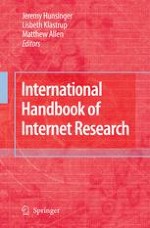2010 | OriginalPaper | Chapter
Intercreativity: Mapping Online Activism
Author : Graham Meikle
Published in: International Handbook of Internet Research
Publisher: Springer Netherlands
Activate our intelligent search to find suitable subject content or patents.
Select sections of text to find matching patents with Artificial Intelligence. powered by
Select sections of text to find additional relevant content using AI-assisted search. powered by
